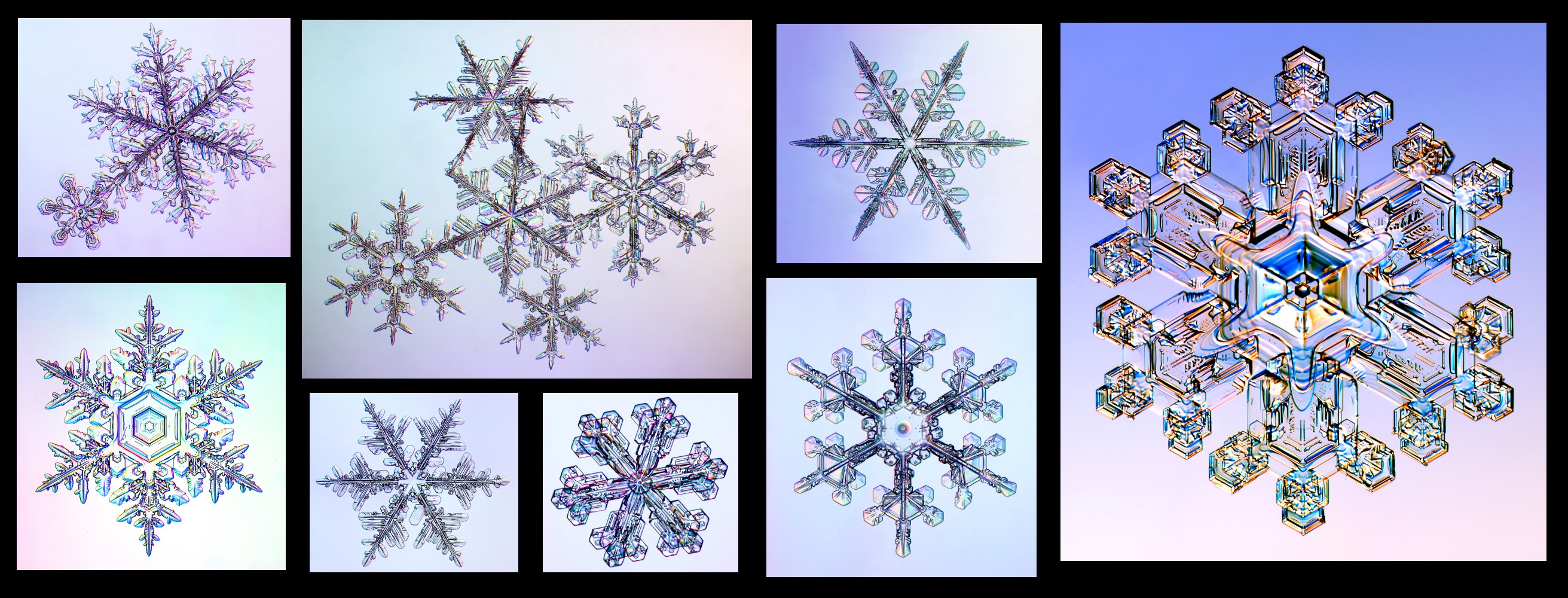Explain the Difference Between Snowflakes and Snow Crystals
What is the major difference between a crystal and an amorphous solid. Most fluffy-looking clouds are made of tiny liquid water drops while high thin clouds are made of tiny ice crystals.
As the ice crystal grows water can freeze onto its six corners multiple times causing the snowflake to develop a unique yet still six-sided shape.

. It can mean an individual snow crystal or a few snow crystals stuck together or large agglomerations of snow crystals that form puff-balls that float down from the clouds. A snowflake is a more general term. Snowflakes have characteristic shapes because they consist of water molecules which have a bent shape.
Often the crystals combine with other crystals and grow into snowflakes. Larger and irregular snowflakes are formed when the temperature is near to freezing point with light winds convective and unstable atmospheric conditions. What are the differences between snow and snow showers.
Snow pellets or graupel are opaque ice particles in the atmosphere. It can mean an individual snow crystal or a few snow crystals stuck together or large agglomerations of snow crystals that form puff-balls that float down from the clouds. The main factor affecting snowflake shape is temperature.
Sometimes a snowflake turns into just a ball of rime which is then called graupel or soft hail. Droplets that freeze onto a snow crystal are called rime and these pictures show crystals that picked up a little rime and a lot of rime. Snow is not frozen rain.
Under a microscope one can see. In general larger snowflakes are formed when the temperature of the air near the ground is a little below freezing This is because of the moisture content in the air which is a little high. The simplest sectored plates are hexagonal crystals that are divided into six equal pieces like the slices of a hexagonal pie.
Snowflakes are clusters of ice crystals that fall from a cloud. The appearance of snow is very different from that of rain. As the ice crystal falls to the ground water vapor freezes onto the primary crystal building new crystals the six arms of the snowflake.
They resemble lacy hexagons. Most snowflakes are flat crystals that have six sides. They form as ice crystals fall through supercooled cloud droplets which are below freezing but remain a liquid.
A snow crystal is a single crystal of ice. The more detailed explanation is this. While amorphous solids have a random arrangement of particles.
Explain the difference between snowflakes and snow crystals. A snow crystal is a single crystal of ice. Crystalline structures have a definite arrangement of particles.
Water vapor is attracted to and clings to very small condensation nuclei like dust or airborne salt or even other snow crystals. Snow crystals form when water vapor condenses directly into ice. A snow crystal as the name implies is a single crystal of ice.
As the snow falls it will touch the warm parts of the earth causing the snowflakes to melt into a liquid. A snowflake is a general term for an individual snow crystal a few snow crystals stuck together or large agglomerations of. Temperature determines the shape of a crystal as it forms and also changes that shape as it melts.
Snowflakes have a six-sided structure because ice does. The molecules are too close together. A snowflake is a general term for an individual snow crystal a few snow crystals stuck together or large agglomerations of snow crystals that form puff-balls.
A snowflake is a more general term. How do snow crystals form. It can mean an individual snow crystal or a few snow crystals stuck together or large agglomerations of snow crystals that form puff-balls that float down from the clouds.
How many snow crystals does it take to make a snowflake. Snow is precipitation in the form of ice crystals. When water freezes into individual ice crystals its molecules stack together to form a hexagonal lattice.
Thats the short answer. Snowflakes and snow crystals by using the Web site below to answer the questions. The ice crystals that make up snowflakes are symmetrical or patterned because they reflect the internal order of the crystals water.
A snowflake is a general term for an individual snow crystal a few snow crystals stuck together or large agglomerations of snow crystals that form puff-balls What is the simplest type of snowflake. This creates an ice crystal. A snow crystal as the name implies is a single crystal of ice.
A snow crystal as the name implies is a single crystal of ice. Snow is formed by the precipitation of tiny ice crystals which fall from the clouds. A snow crystal is a single crystal of ice.
A snow crystal is a single crystal of ice. As nouns the difference between snowflake and snow is that snowflake is a crystal of snow having approximate hexagonal symmetry while snow is uncountable the frozen crystalline state of water that falls as precipitation. Snow crystals are therefore made mostly from water vapor not.
Irregulars Snowflakes can have a hard life blowing about in a turbulent cloud so that many. A snowflake is a more general term. Explain the difference between snowflakes and snow crystals.
When snowflakes fall they appear. What makes a snow crystal. A snowflake is a general term for an individual snow crystal a few snow crystals stuck together or large agglomerations of snow crystals that form puff-balls 2.

The Nakaya Snow Crystal Morphology Diagram Showing Different Types Of Download Scientific Diagram

Snow Crystals A Natural Blend Of Science And Art Weather Underground
0 Response to "Explain the Difference Between Snowflakes and Snow Crystals"
Post a Comment